12 – Organisational Behaviour
VerifiedAdded on 2023/01/03
|14
|4579
|80
AI Summary
Contribute Materials
Your contribution can guide someone’s learning journey. Share your
documents today.
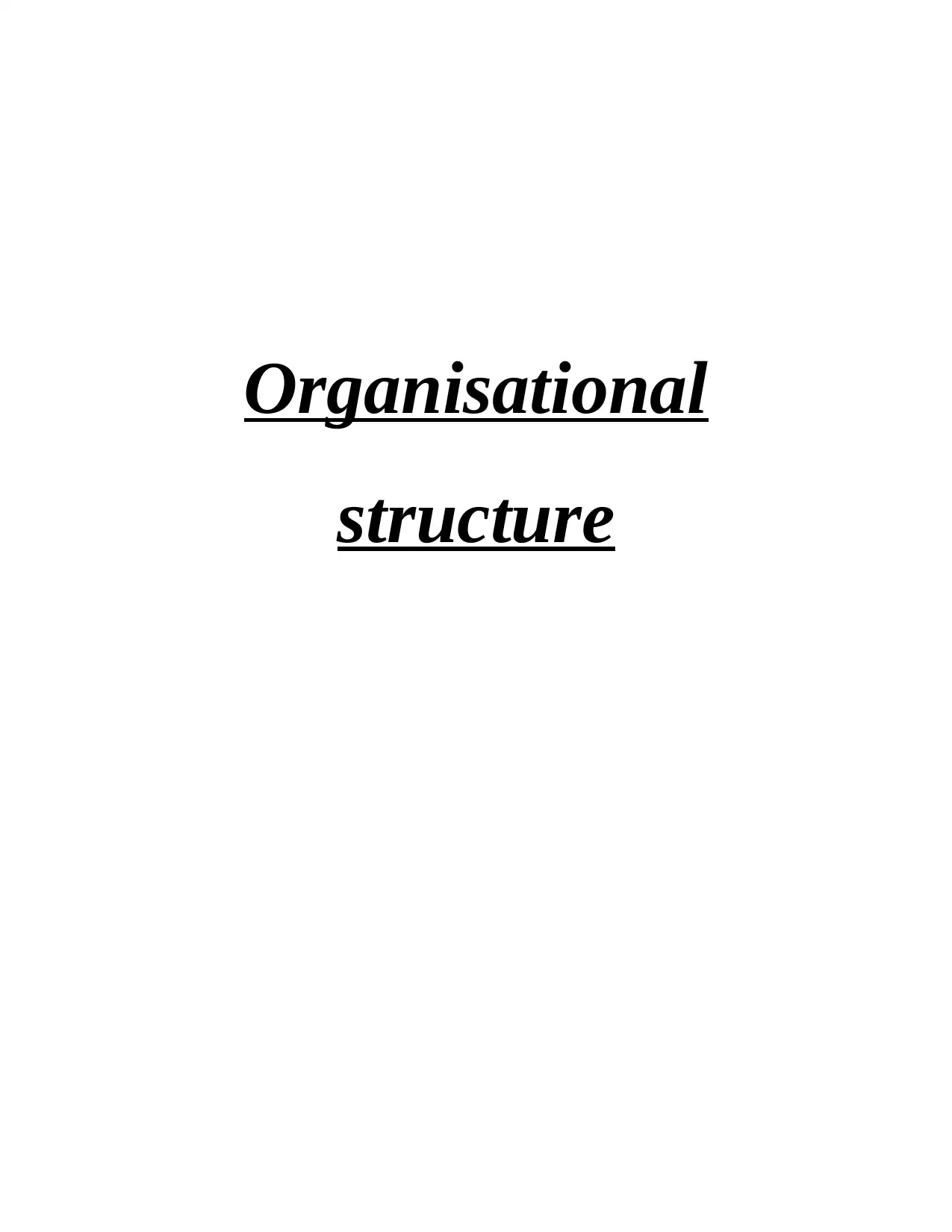
Organisational
structure
structure
Secure Best Marks with AI Grader
Need help grading? Try our AI Grader for instant feedback on your assignments.
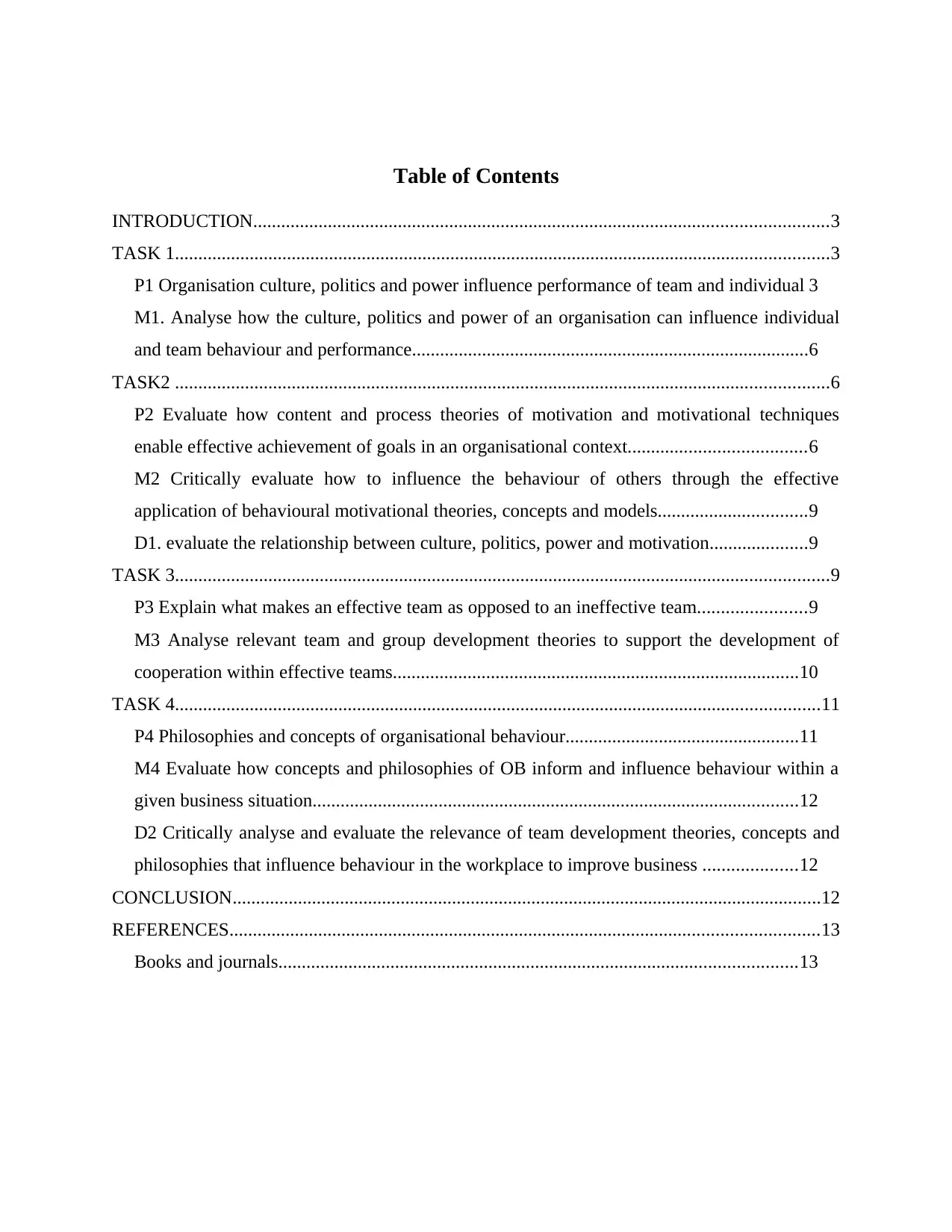
Table of Contents
INTRODUCTION...........................................................................................................................3
TASK 1............................................................................................................................................3
P1 Organisation culture, politics and power influence performance of team and individual 3
M1. Analyse how the culture, politics and power of an organisation can influence individual
and team behaviour and performance.....................................................................................6
TASK2 ............................................................................................................................................6
P2 Evaluate how content and process theories of motivation and motivational techniques
enable effective achievement of goals in an organisational context......................................6
M2 Critically evaluate how to influence the behaviour of others through the effective
application of behavioural motivational theories, concepts and models................................9
D1. evaluate the relationship between culture, politics, power and motivation.....................9
TASK 3............................................................................................................................................9
P3 Explain what makes an effective team as opposed to an ineffective team.......................9
M3 Analyse relevant team and group development theories to support the development of
cooperation within effective teams.......................................................................................10
TASK 4..........................................................................................................................................11
P4 Philosophies and concepts of organisational behaviour..................................................11
M4 Evaluate how concepts and philosophies of OB inform and influence behaviour within a
given business situation........................................................................................................12
D2 Critically analyse and evaluate the relevance of team development theories, concepts and
philosophies that influence behaviour in the workplace to improve business ....................12
CONCLUSION..............................................................................................................................12
REFERENCES..............................................................................................................................13
Books and journals...............................................................................................................13
INTRODUCTION...........................................................................................................................3
TASK 1............................................................................................................................................3
P1 Organisation culture, politics and power influence performance of team and individual 3
M1. Analyse how the culture, politics and power of an organisation can influence individual
and team behaviour and performance.....................................................................................6
TASK2 ............................................................................................................................................6
P2 Evaluate how content and process theories of motivation and motivational techniques
enable effective achievement of goals in an organisational context......................................6
M2 Critically evaluate how to influence the behaviour of others through the effective
application of behavioural motivational theories, concepts and models................................9
D1. evaluate the relationship between culture, politics, power and motivation.....................9
TASK 3............................................................................................................................................9
P3 Explain what makes an effective team as opposed to an ineffective team.......................9
M3 Analyse relevant team and group development theories to support the development of
cooperation within effective teams.......................................................................................10
TASK 4..........................................................................................................................................11
P4 Philosophies and concepts of organisational behaviour..................................................11
M4 Evaluate how concepts and philosophies of OB inform and influence behaviour within a
given business situation........................................................................................................12
D2 Critically analyse and evaluate the relevance of team development theories, concepts and
philosophies that influence behaviour in the workplace to improve business ....................12
CONCLUSION..............................................................................................................................12
REFERENCES..............................................................................................................................13
Books and journals...............................................................................................................13
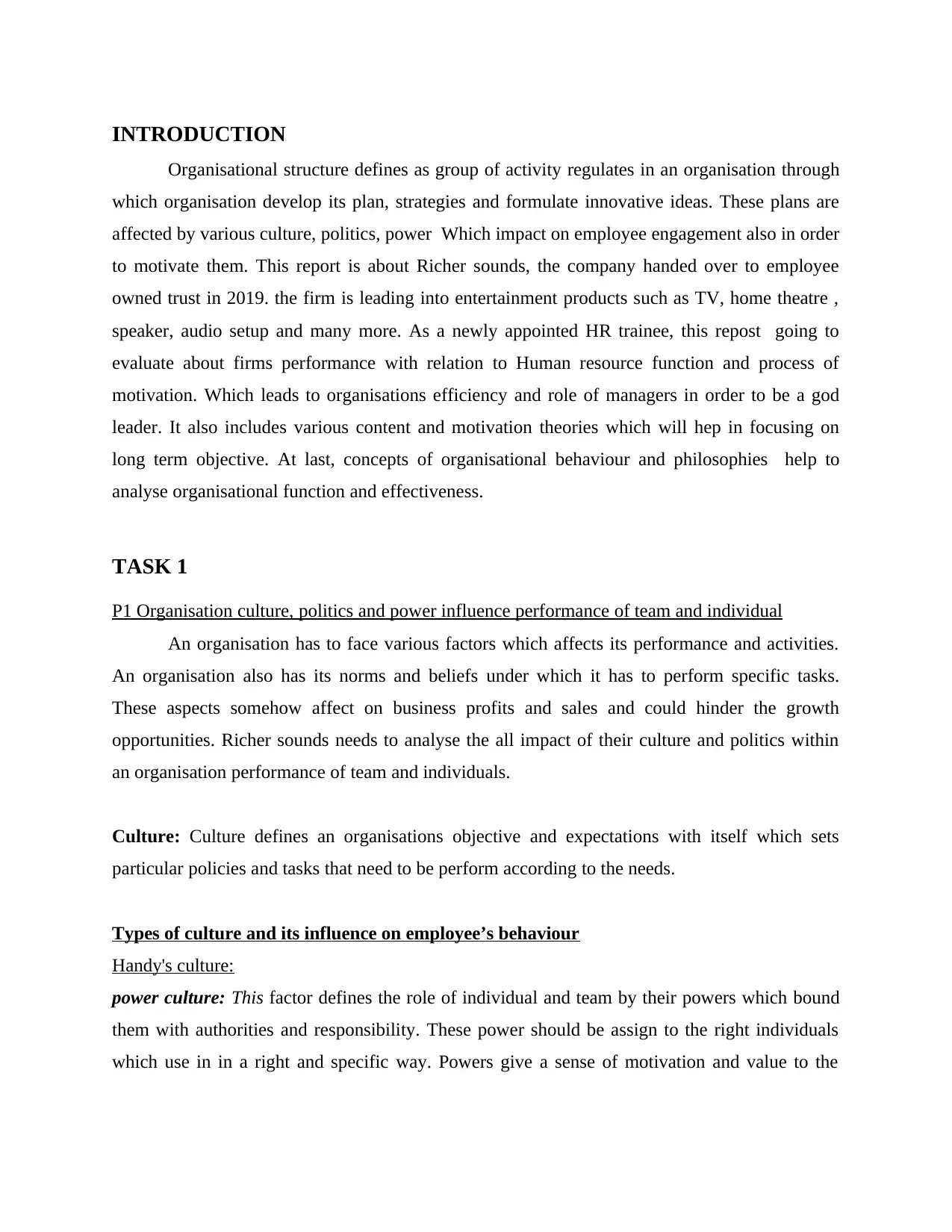
INTRODUCTION
Organisational structure defines as group of activity regulates in an organisation through
which organisation develop its plan, strategies and formulate innovative ideas. These plans are
affected by various culture, politics, power Which impact on employee engagement also in order
to motivate them. This report is about Richer sounds, the company handed over to employee
owned trust in 2019. the firm is leading into entertainment products such as TV, home theatre ,
speaker, audio setup and many more. As a newly appointed HR trainee, this repost going to
evaluate about firms performance with relation to Human resource function and process of
motivation. Which leads to organisations efficiency and role of managers in order to be a god
leader. It also includes various content and motivation theories which will hep in focusing on
long term objective. At last, concepts of organisational behaviour and philosophies help to
analyse organisational function and effectiveness.
TASK 1
P1 Organisation culture, politics and power influence performance of team and individual
An organisation has to face various factors which affects its performance and activities.
An organisation also has its norms and beliefs under which it has to perform specific tasks.
These aspects somehow affect on business profits and sales and could hinder the growth
opportunities. Richer sounds needs to analyse the all impact of their culture and politics within
an organisation performance of team and individuals.
Culture: Culture defines an organisations objective and expectations with itself which sets
particular policies and tasks that need to be perform according to the needs.
Types of culture and its influence on employee’s behaviour
Handy's culture:
power culture: This factor defines the role of individual and team by their powers which bound
them with authorities and responsibility. These power should be assign to the right individuals
which use in in a right and specific way. Powers give a sense of motivation and value to the
Organisational structure defines as group of activity regulates in an organisation through
which organisation develop its plan, strategies and formulate innovative ideas. These plans are
affected by various culture, politics, power Which impact on employee engagement also in order
to motivate them. This report is about Richer sounds, the company handed over to employee
owned trust in 2019. the firm is leading into entertainment products such as TV, home theatre ,
speaker, audio setup and many more. As a newly appointed HR trainee, this repost going to
evaluate about firms performance with relation to Human resource function and process of
motivation. Which leads to organisations efficiency and role of managers in order to be a god
leader. It also includes various content and motivation theories which will hep in focusing on
long term objective. At last, concepts of organisational behaviour and philosophies help to
analyse organisational function and effectiveness.
TASK 1
P1 Organisation culture, politics and power influence performance of team and individual
An organisation has to face various factors which affects its performance and activities.
An organisation also has its norms and beliefs under which it has to perform specific tasks.
These aspects somehow affect on business profits and sales and could hinder the growth
opportunities. Richer sounds needs to analyse the all impact of their culture and politics within
an organisation performance of team and individuals.
Culture: Culture defines an organisations objective and expectations with itself which sets
particular policies and tasks that need to be perform according to the needs.
Types of culture and its influence on employee’s behaviour
Handy's culture:
power culture: This factor defines the role of individual and team by their powers which bound
them with authorities and responsibility. These power should be assign to the right individuals
which use in in a right and specific way. Powers give a sense of motivation and value to the
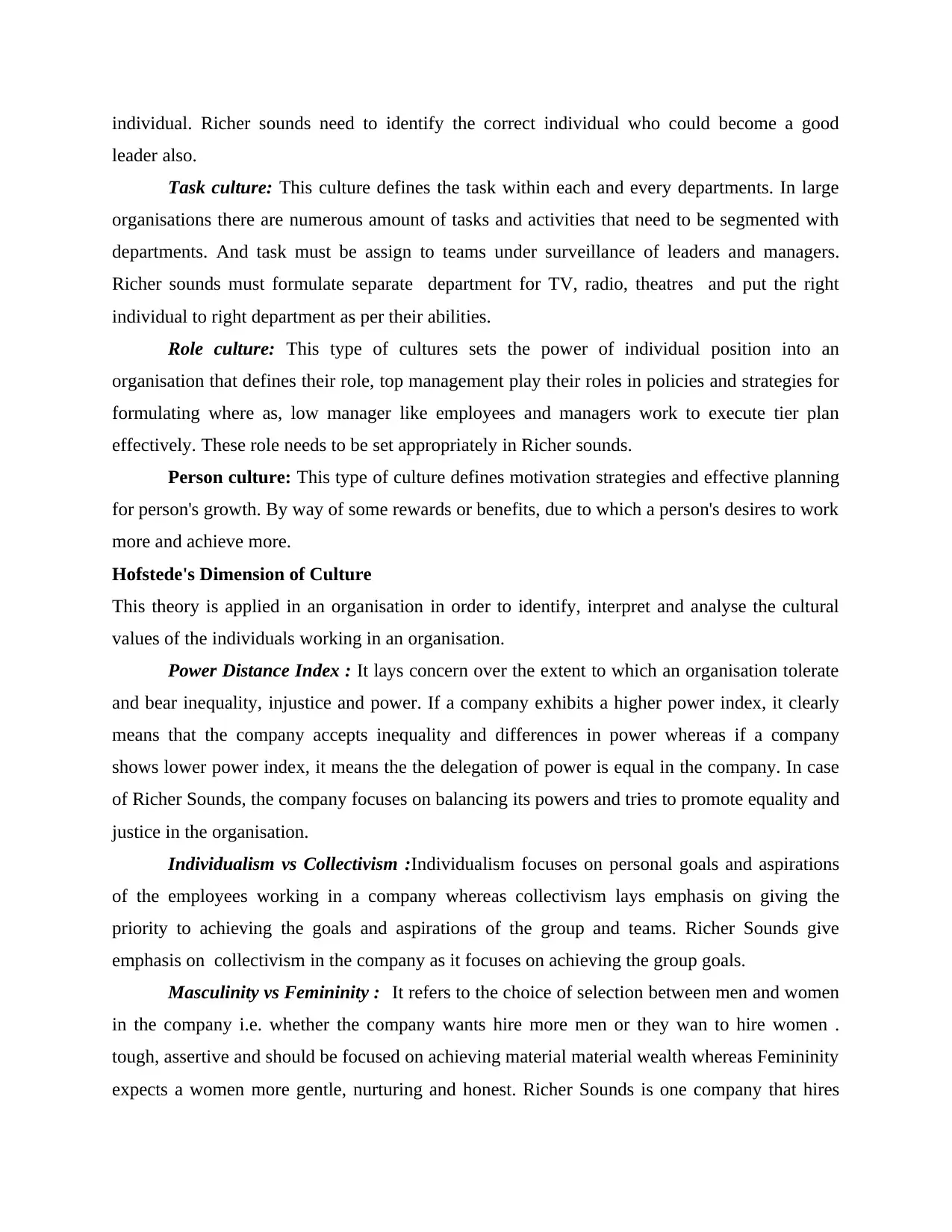
individual. Richer sounds need to identify the correct individual who could become a good
leader also.
Task culture: This culture defines the task within each and every departments. In large
organisations there are numerous amount of tasks and activities that need to be segmented with
departments. And task must be assign to teams under surveillance of leaders and managers.
Richer sounds must formulate separate department for TV, radio, theatres and put the right
individual to right department as per their abilities.
Role culture: This type of cultures sets the power of individual position into an
organisation that defines their role, top management play their roles in policies and strategies for
formulating where as, low manager like employees and managers work to execute tier plan
effectively. These role needs to be set appropriately in Richer sounds.
Person culture: This type of culture defines motivation strategies and effective planning
for person's growth. By way of some rewards or benefits, due to which a person's desires to work
more and achieve more.
Hofstede's Dimension of Culture
This theory is applied in an organisation in order to identify, interpret and analyse the cultural
values of the individuals working in an organisation.
Power Distance Index : It lays concern over the extent to which an organisation tolerate
and bear inequality, injustice and power. If a company exhibits a higher power index, it clearly
means that the company accepts inequality and differences in power whereas if a company
shows lower power index, it means the the delegation of power is equal in the company. In case
of Richer Sounds, the company focuses on balancing its powers and tries to promote equality and
justice in the organisation.
Individualism vs Collectivism :Individualism focuses on personal goals and aspirations
of the employees working in a company whereas collectivism lays emphasis on giving the
priority to achieving the goals and aspirations of the group and teams. Richer Sounds give
emphasis on collectivism in the company as it focuses on achieving the group goals.
Masculinity vs Femininity : It refers to the choice of selection between men and women
in the company i.e. whether the company wants hire more men or they wan to hire women .
tough, assertive and should be focused on achieving material material wealth whereas Femininity
expects a women more gentle, nurturing and honest. Richer Sounds is one company that hires
leader also.
Task culture: This culture defines the task within each and every departments. In large
organisations there are numerous amount of tasks and activities that need to be segmented with
departments. And task must be assign to teams under surveillance of leaders and managers.
Richer sounds must formulate separate department for TV, radio, theatres and put the right
individual to right department as per their abilities.
Role culture: This type of cultures sets the power of individual position into an
organisation that defines their role, top management play their roles in policies and strategies for
formulating where as, low manager like employees and managers work to execute tier plan
effectively. These role needs to be set appropriately in Richer sounds.
Person culture: This type of culture defines motivation strategies and effective planning
for person's growth. By way of some rewards or benefits, due to which a person's desires to work
more and achieve more.
Hofstede's Dimension of Culture
This theory is applied in an organisation in order to identify, interpret and analyse the cultural
values of the individuals working in an organisation.
Power Distance Index : It lays concern over the extent to which an organisation tolerate
and bear inequality, injustice and power. If a company exhibits a higher power index, it clearly
means that the company accepts inequality and differences in power whereas if a company
shows lower power index, it means the the delegation of power is equal in the company. In case
of Richer Sounds, the company focuses on balancing its powers and tries to promote equality and
justice in the organisation.
Individualism vs Collectivism :Individualism focuses on personal goals and aspirations
of the employees working in a company whereas collectivism lays emphasis on giving the
priority to achieving the goals and aspirations of the group and teams. Richer Sounds give
emphasis on collectivism in the company as it focuses on achieving the group goals.
Masculinity vs Femininity : It refers to the choice of selection between men and women
in the company i.e. whether the company wants hire more men or they wan to hire women .
tough, assertive and should be focused on achieving material material wealth whereas Femininity
expects a women more gentle, nurturing and honest. Richer Sounds is one company that hires
Secure Best Marks with AI Grader
Need help grading? Try our AI Grader for instant feedback on your assignments.
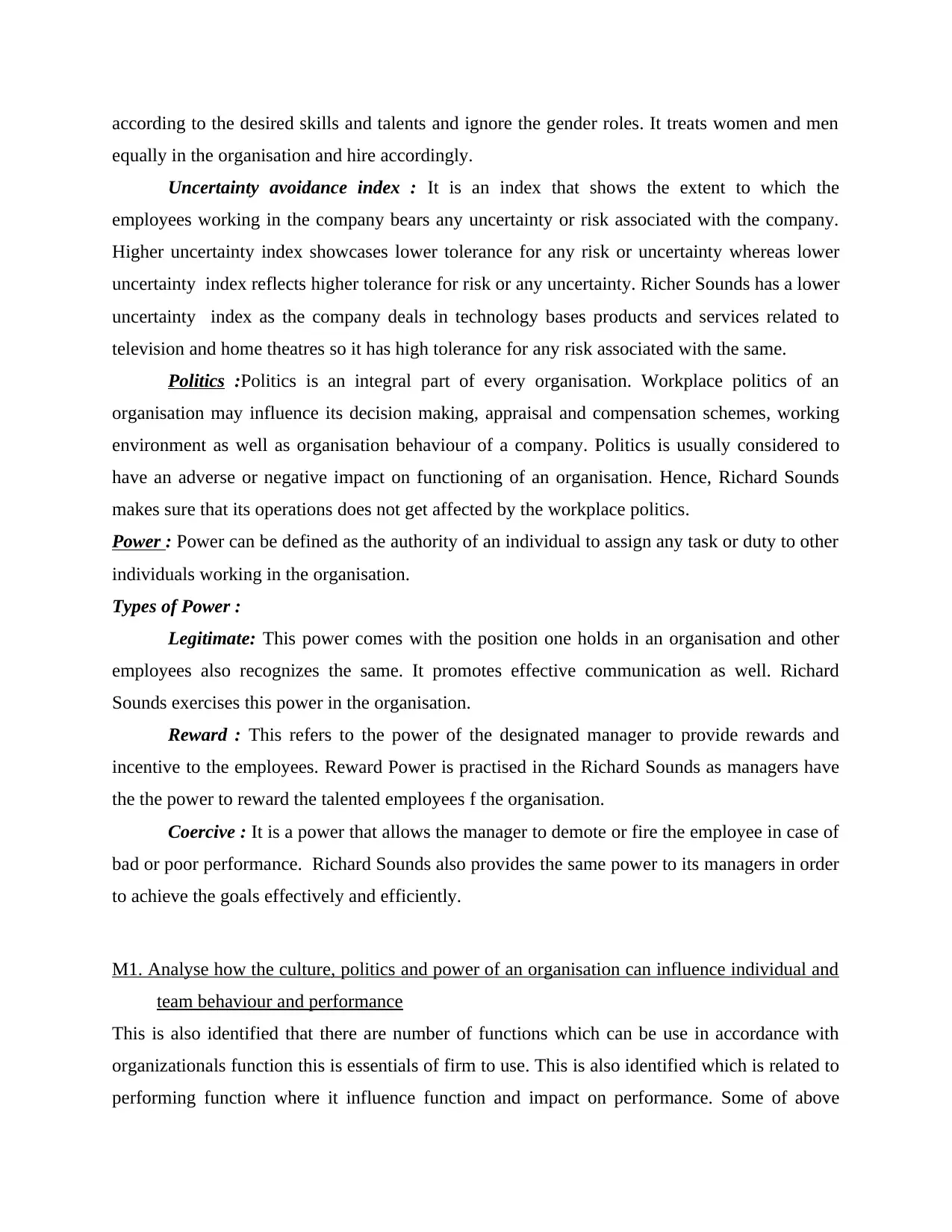
according to the desired skills and talents and ignore the gender roles. It treats women and men
equally in the organisation and hire accordingly.
Uncertainty avoidance index : It is an index that shows the extent to which the
employees working in the company bears any uncertainty or risk associated with the company.
Higher uncertainty index showcases lower tolerance for any risk or uncertainty whereas lower
uncertainty index reflects higher tolerance for risk or any uncertainty. Richer Sounds has a lower
uncertainty index as the company deals in technology bases products and services related to
television and home theatres so it has high tolerance for any risk associated with the same.
Politics :Politics is an integral part of every organisation. Workplace politics of an
organisation may influence its decision making, appraisal and compensation schemes, working
environment as well as organisation behaviour of a company. Politics is usually considered to
have an adverse or negative impact on functioning of an organisation. Hence, Richard Sounds
makes sure that its operations does not get affected by the workplace politics.
Power : Power can be defined as the authority of an individual to assign any task or duty to other
individuals working in the organisation.
Types of Power :
Legitimate: This power comes with the position one holds in an organisation and other
employees also recognizes the same. It promotes effective communication as well. Richard
Sounds exercises this power in the organisation.
Reward : This refers to the power of the designated manager to provide rewards and
incentive to the employees. Reward Power is practised in the Richard Sounds as managers have
the the power to reward the talented employees f the organisation.
Coercive : It is a power that allows the manager to demote or fire the employee in case of
bad or poor performance. Richard Sounds also provides the same power to its managers in order
to achieve the goals effectively and efficiently.
M1. Analyse how the culture, politics and power of an organisation can influence individual and
team behaviour and performance
This is also identified that there are number of functions which can be use in accordance with
organizationals function this is essentials of firm to use. This is also identified which is related to
performing function where it influence function and impact on performance. Some of above
equally in the organisation and hire accordingly.
Uncertainty avoidance index : It is an index that shows the extent to which the
employees working in the company bears any uncertainty or risk associated with the company.
Higher uncertainty index showcases lower tolerance for any risk or uncertainty whereas lower
uncertainty index reflects higher tolerance for risk or any uncertainty. Richer Sounds has a lower
uncertainty index as the company deals in technology bases products and services related to
television and home theatres so it has high tolerance for any risk associated with the same.
Politics :Politics is an integral part of every organisation. Workplace politics of an
organisation may influence its decision making, appraisal and compensation schemes, working
environment as well as organisation behaviour of a company. Politics is usually considered to
have an adverse or negative impact on functioning of an organisation. Hence, Richard Sounds
makes sure that its operations does not get affected by the workplace politics.
Power : Power can be defined as the authority of an individual to assign any task or duty to other
individuals working in the organisation.
Types of Power :
Legitimate: This power comes with the position one holds in an organisation and other
employees also recognizes the same. It promotes effective communication as well. Richard
Sounds exercises this power in the organisation.
Reward : This refers to the power of the designated manager to provide rewards and
incentive to the employees. Reward Power is practised in the Richard Sounds as managers have
the the power to reward the talented employees f the organisation.
Coercive : It is a power that allows the manager to demote or fire the employee in case of
bad or poor performance. Richard Sounds also provides the same power to its managers in order
to achieve the goals effectively and efficiently.
M1. Analyse how the culture, politics and power of an organisation can influence individual and
team behaviour and performance
This is also identified that there are number of functions which can be use in accordance with
organizationals function this is essentials of firm to use. This is also identified which is related to
performing function where it influence function and impact on performance. Some of above
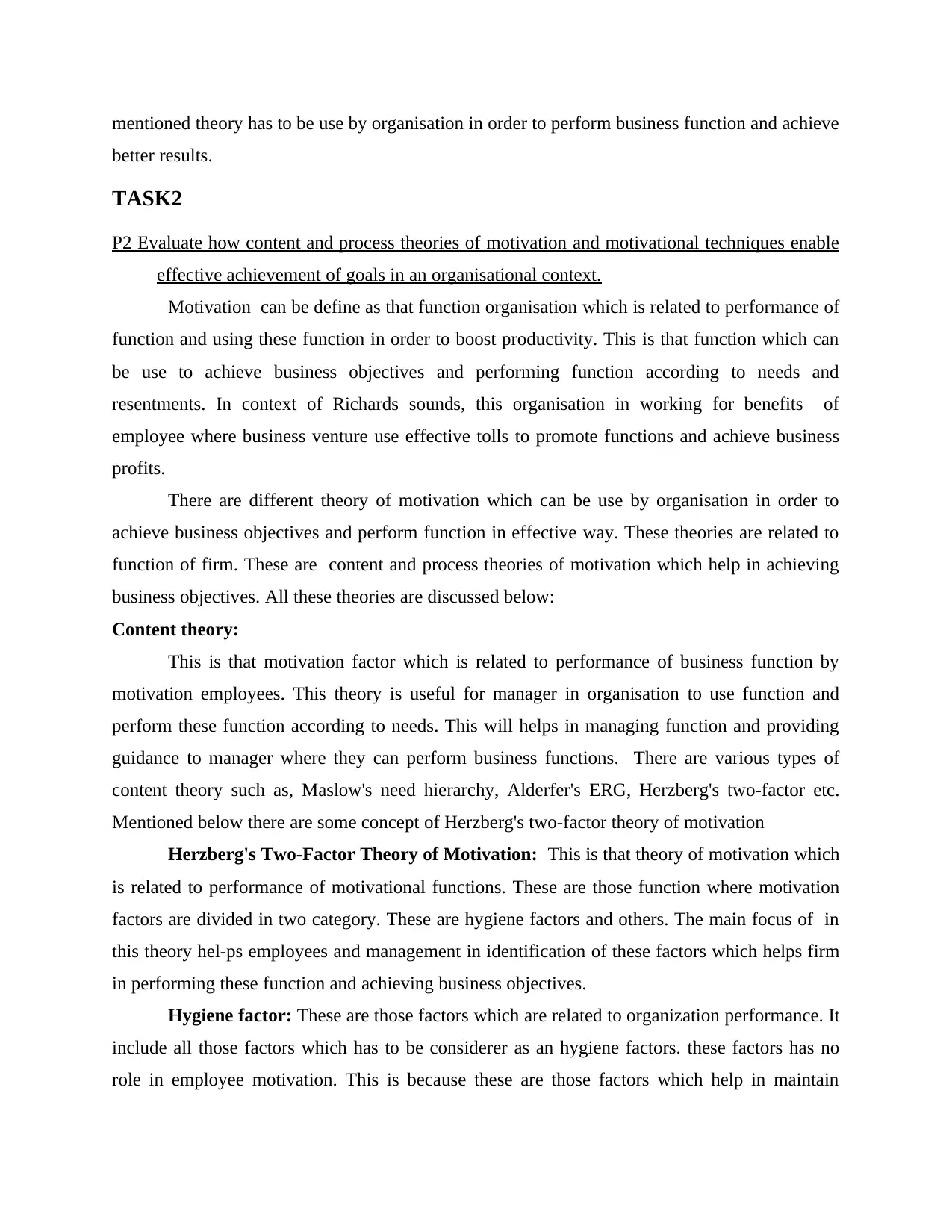
mentioned theory has to be use by organisation in order to perform business function and achieve
better results.
TASK2
P2 Evaluate how content and process theories of motivation and motivational techniques enable
effective achievement of goals in an organisational context.
Motivation can be define as that function organisation which is related to performance of
function and using these function in order to boost productivity. This is that function which can
be use to achieve business objectives and performing function according to needs and
resentments. In context of Richards sounds, this organisation in working for benefits of
employee where business venture use effective tolls to promote functions and achieve business
profits.
There are different theory of motivation which can be use by organisation in order to
achieve business objectives and perform function in effective way. These theories are related to
function of firm. These are content and process theories of motivation which help in achieving
business objectives. All these theories are discussed below:
Content theory:
This is that motivation factor which is related to performance of business function by
motivation employees. This theory is useful for manager in organisation to use function and
perform these function according to needs. This will helps in managing function and providing
guidance to manager where they can perform business functions. There are various types of
content theory such as, Maslow's need hierarchy, Alderfer's ERG, Herzberg's two-factor etc.
Mentioned below there are some concept of Herzberg's two-factor theory of motivation
Herzberg's Two-Factor Theory of Motivation: This is that theory of motivation which
is related to performance of motivational functions. These are those function where motivation
factors are divided in two category. These are hygiene factors and others. The main focus of in
this theory hel-ps employees and management in identification of these factors which helps firm
in performing these function and achieving business objectives.
Hygiene factor: These are those factors which are related to organization performance. It
include all those factors which has to be considerer as an hygiene factors. these factors has no
role in employee motivation. This is because these are those factors which help in maintain
better results.
TASK2
P2 Evaluate how content and process theories of motivation and motivational techniques enable
effective achievement of goals in an organisational context.
Motivation can be define as that function organisation which is related to performance of
function and using these function in order to boost productivity. This is that function which can
be use to achieve business objectives and performing function according to needs and
resentments. In context of Richards sounds, this organisation in working for benefits of
employee where business venture use effective tolls to promote functions and achieve business
profits.
There are different theory of motivation which can be use by organisation in order to
achieve business objectives and perform function in effective way. These theories are related to
function of firm. These are content and process theories of motivation which help in achieving
business objectives. All these theories are discussed below:
Content theory:
This is that motivation factor which is related to performance of business function by
motivation employees. This theory is useful for manager in organisation to use function and
perform these function according to needs. This will helps in managing function and providing
guidance to manager where they can perform business functions. There are various types of
content theory such as, Maslow's need hierarchy, Alderfer's ERG, Herzberg's two-factor etc.
Mentioned below there are some concept of Herzberg's two-factor theory of motivation
Herzberg's Two-Factor Theory of Motivation: This is that theory of motivation which
is related to performance of motivational functions. These are those function where motivation
factors are divided in two category. These are hygiene factors and others. The main focus of in
this theory hel-ps employees and management in identification of these factors which helps firm
in performing these function and achieving business objectives.
Hygiene factor: These are those factors which are related to organization performance. It
include all those factors which has to be considerer as an hygiene factors. these factors has no
role in employee motivation. This is because these are those factors which help in maintain
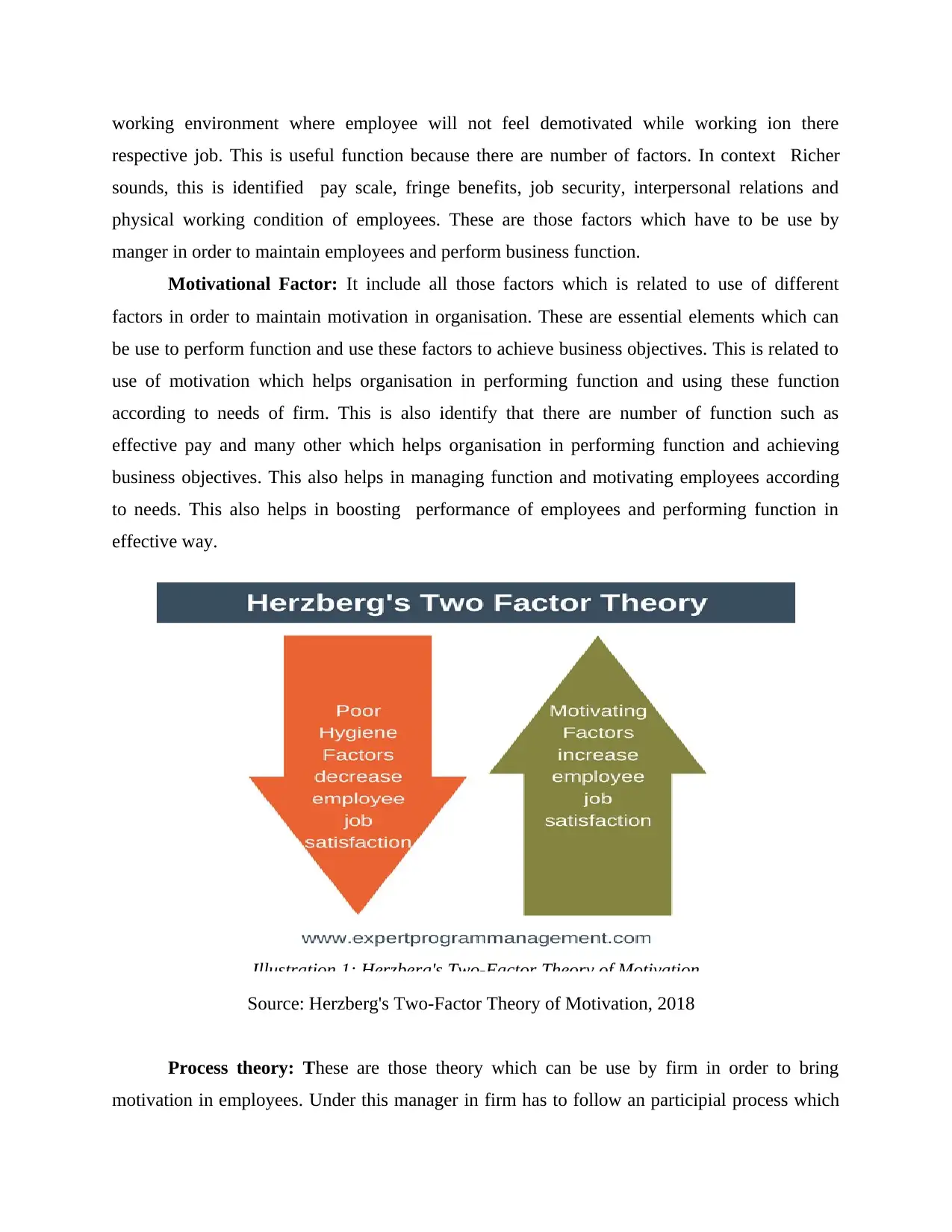
working environment where employee will not feel demotivated while working ion there
respective job. This is useful function because there are number of factors. In context Richer
sounds, this is identified pay scale, fringe benefits, job security, interpersonal relations and
physical working condition of employees. These are those factors which have to be use by
manger in order to maintain employees and perform business function.
Motivational Factor: It include all those factors which is related to use of different
factors in order to maintain motivation in organisation. These are essential elements which can
be use to perform function and use these factors to achieve business objectives. This is related to
use of motivation which helps organisation in performing function and using these function
according to needs of firm. This is also identify that there are number of function such as
effective pay and many other which helps organisation in performing function and achieving
business objectives. This also helps in managing function and motivating employees according
to needs. This also helps in boosting performance of employees and performing function in
effective way.
Source: Herzberg's Two-Factor Theory of Motivation, 2018
Process theory: These are those theory which can be use by firm in order to bring
motivation in employees. Under this manager in firm has to follow an participial process which
Illustration 1: Herzberg's Two-Factor Theory of Motivation
respective job. This is useful function because there are number of factors. In context Richer
sounds, this is identified pay scale, fringe benefits, job security, interpersonal relations and
physical working condition of employees. These are those factors which have to be use by
manger in order to maintain employees and perform business function.
Motivational Factor: It include all those factors which is related to use of different
factors in order to maintain motivation in organisation. These are essential elements which can
be use to perform function and use these factors to achieve business objectives. This is related to
use of motivation which helps organisation in performing function and using these function
according to needs of firm. This is also identify that there are number of function such as
effective pay and many other which helps organisation in performing function and achieving
business objectives. This also helps in managing function and motivating employees according
to needs. This also helps in boosting performance of employees and performing function in
effective way.
Source: Herzberg's Two-Factor Theory of Motivation, 2018
Process theory: These are those theory which can be use by firm in order to bring
motivation in employees. Under this manager in firm has to follow an participial process which
Illustration 1: Herzberg's Two-Factor Theory of Motivation
Paraphrase This Document
Need a fresh take? Get an instant paraphrase of this document with our AI Paraphraser
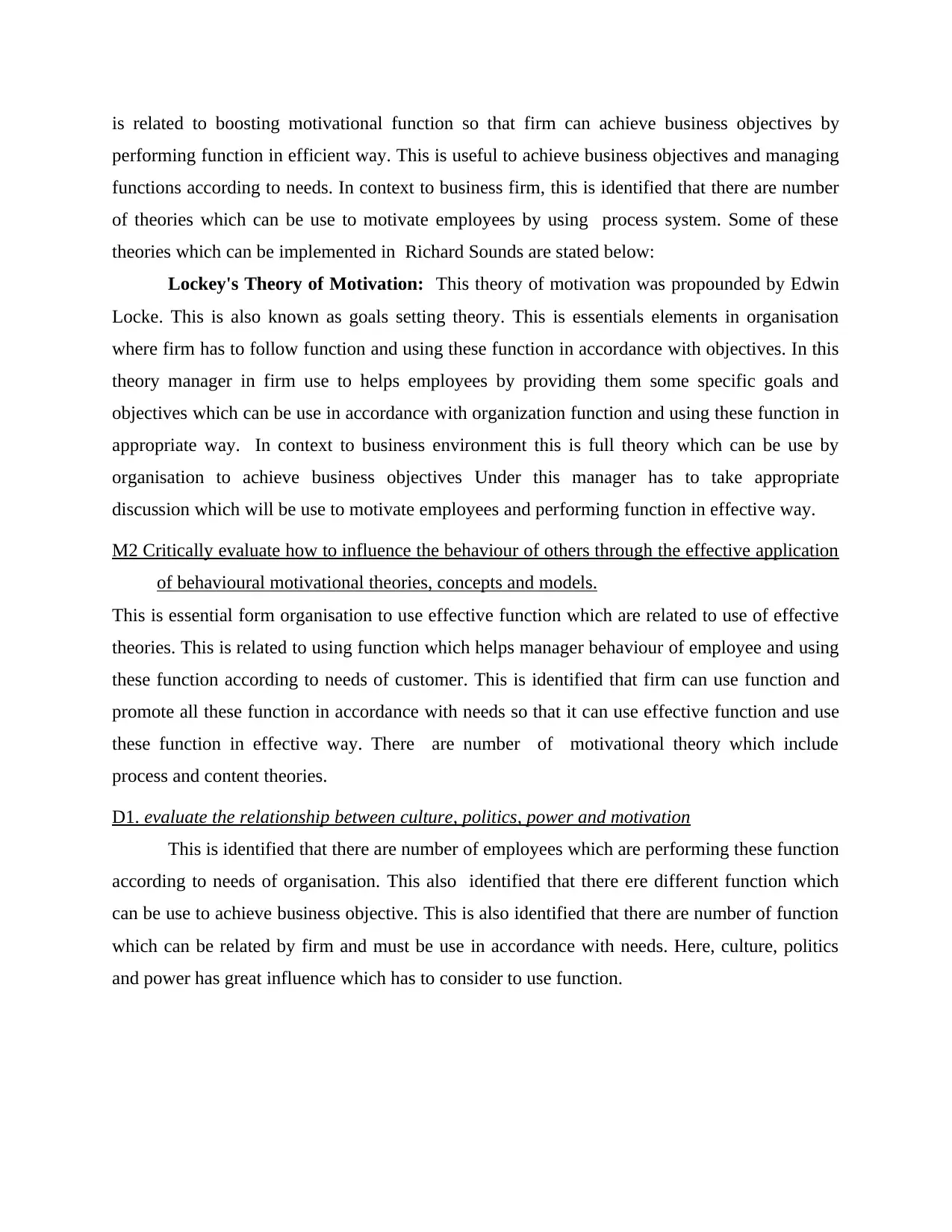
is related to boosting motivational function so that firm can achieve business objectives by
performing function in efficient way. This is useful to achieve business objectives and managing
functions according to needs. In context to business firm, this is identified that there are number
of theories which can be use to motivate employees by using process system. Some of these
theories which can be implemented in Richard Sounds are stated below:
Lockey's Theory of Motivation: This theory of motivation was propounded by Edwin
Locke. This is also known as goals setting theory. This is essentials elements in organisation
where firm has to follow function and using these function in accordance with objectives. In this
theory manager in firm use to helps employees by providing them some specific goals and
objectives which can be use in accordance with organization function and using these function in
appropriate way. In context to business environment this is full theory which can be use by
organisation to achieve business objectives Under this manager has to take appropriate
discussion which will be use to motivate employees and performing function in effective way.
M2 Critically evaluate how to influence the behaviour of others through the effective application
of behavioural motivational theories, concepts and models.
This is essential form organisation to use effective function which are related to use of effective
theories. This is related to using function which helps manager behaviour of employee and using
these function according to needs of customer. This is identified that firm can use function and
promote all these function in accordance with needs so that it can use effective function and use
these function in effective way. There are number of motivational theory which include
process and content theories.
D1. evaluate the relationship between culture, politics, power and motivation
This is identified that there are number of employees which are performing these function
according to needs of organisation. This also identified that there ere different function which
can be use to achieve business objective. This is also identified that there are number of function
which can be related by firm and must be use in accordance with needs. Here, culture, politics
and power has great influence which has to consider to use function.
performing function in efficient way. This is useful to achieve business objectives and managing
functions according to needs. In context to business firm, this is identified that there are number
of theories which can be use to motivate employees by using process system. Some of these
theories which can be implemented in Richard Sounds are stated below:
Lockey's Theory of Motivation: This theory of motivation was propounded by Edwin
Locke. This is also known as goals setting theory. This is essentials elements in organisation
where firm has to follow function and using these function in accordance with objectives. In this
theory manager in firm use to helps employees by providing them some specific goals and
objectives which can be use in accordance with organization function and using these function in
appropriate way. In context to business environment this is full theory which can be use by
organisation to achieve business objectives Under this manager has to take appropriate
discussion which will be use to motivate employees and performing function in effective way.
M2 Critically evaluate how to influence the behaviour of others through the effective application
of behavioural motivational theories, concepts and models.
This is essential form organisation to use effective function which are related to use of effective
theories. This is related to using function which helps manager behaviour of employee and using
these function according to needs of customer. This is identified that firm can use function and
promote all these function in accordance with needs so that it can use effective function and use
these function in effective way. There are number of motivational theory which include
process and content theories.
D1. evaluate the relationship between culture, politics, power and motivation
This is identified that there are number of employees which are performing these function
according to needs of organisation. This also identified that there ere different function which
can be use to achieve business objective. This is also identified that there are number of function
which can be related by firm and must be use in accordance with needs. Here, culture, politics
and power has great influence which has to consider to use function.
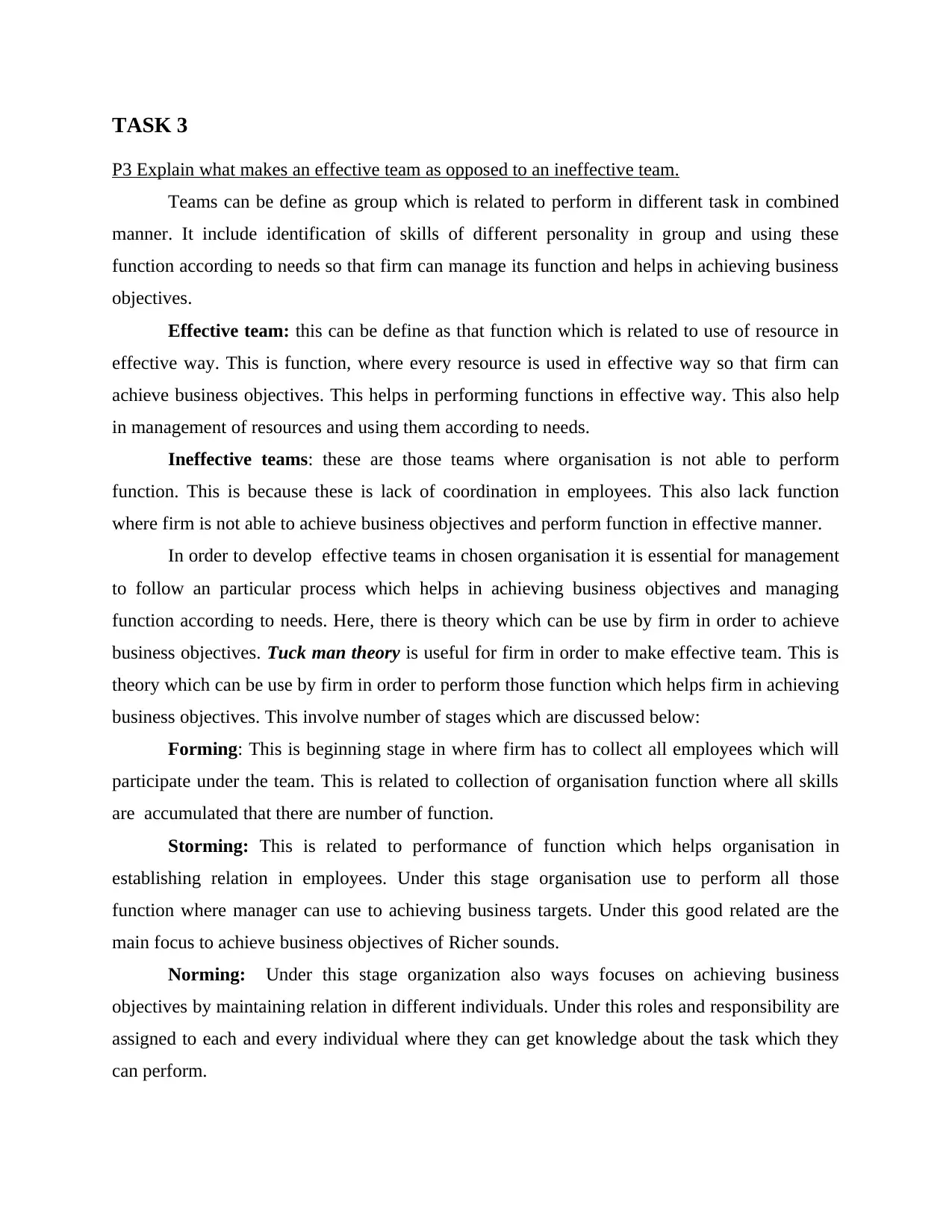
TASK 3
P3 Explain what makes an effective team as opposed to an ineffective team.
Teams can be define as group which is related to perform in different task in combined
manner. It include identification of skills of different personality in group and using these
function according to needs so that firm can manage its function and helps in achieving business
objectives.
Effective team: this can be define as that function which is related to use of resource in
effective way. This is function, where every resource is used in effective way so that firm can
achieve business objectives. This helps in performing functions in effective way. This also help
in management of resources and using them according to needs.
Ineffective teams: these are those teams where organisation is not able to perform
function. This is because these is lack of coordination in employees. This also lack function
where firm is not able to achieve business objectives and perform function in effective manner.
In order to develop effective teams in chosen organisation it is essential for management
to follow an particular process which helps in achieving business objectives and managing
function according to needs. Here, there is theory which can be use by firm in order to achieve
business objectives. Tuck man theory is useful for firm in order to make effective team. This is
theory which can be use by firm in order to perform those function which helps firm in achieving
business objectives. This involve number of stages which are discussed below:
Forming: This is beginning stage in where firm has to collect all employees which will
participate under the team. This is related to collection of organisation function where all skills
are accumulated that there are number of function.
Storming: This is related to performance of function which helps organisation in
establishing relation in employees. Under this stage organisation use to perform all those
function where manager can use to achieving business targets. Under this good related are the
main focus to achieve business objectives of Richer sounds.
Norming: Under this stage organization also ways focuses on achieving business
objectives by maintaining relation in different individuals. Under this roles and responsibility are
assigned to each and every individual where they can get knowledge about the task which they
can perform.
P3 Explain what makes an effective team as opposed to an ineffective team.
Teams can be define as group which is related to perform in different task in combined
manner. It include identification of skills of different personality in group and using these
function according to needs so that firm can manage its function and helps in achieving business
objectives.
Effective team: this can be define as that function which is related to use of resource in
effective way. This is function, where every resource is used in effective way so that firm can
achieve business objectives. This helps in performing functions in effective way. This also help
in management of resources and using them according to needs.
Ineffective teams: these are those teams where organisation is not able to perform
function. This is because these is lack of coordination in employees. This also lack function
where firm is not able to achieve business objectives and perform function in effective manner.
In order to develop effective teams in chosen organisation it is essential for management
to follow an particular process which helps in achieving business objectives and managing
function according to needs. Here, there is theory which can be use by firm in order to achieve
business objectives. Tuck man theory is useful for firm in order to make effective team. This is
theory which can be use by firm in order to perform those function which helps firm in achieving
business objectives. This involve number of stages which are discussed below:
Forming: This is beginning stage in where firm has to collect all employees which will
participate under the team. This is related to collection of organisation function where all skills
are accumulated that there are number of function.
Storming: This is related to performance of function which helps organisation in
establishing relation in employees. Under this stage organisation use to perform all those
function where manager can use to achieving business targets. Under this good related are the
main focus to achieve business objectives of Richer sounds.
Norming: Under this stage organization also ways focuses on achieving business
objectives by maintaining relation in different individuals. Under this roles and responsibility are
assigned to each and every individual where they can get knowledge about the task which they
can perform.
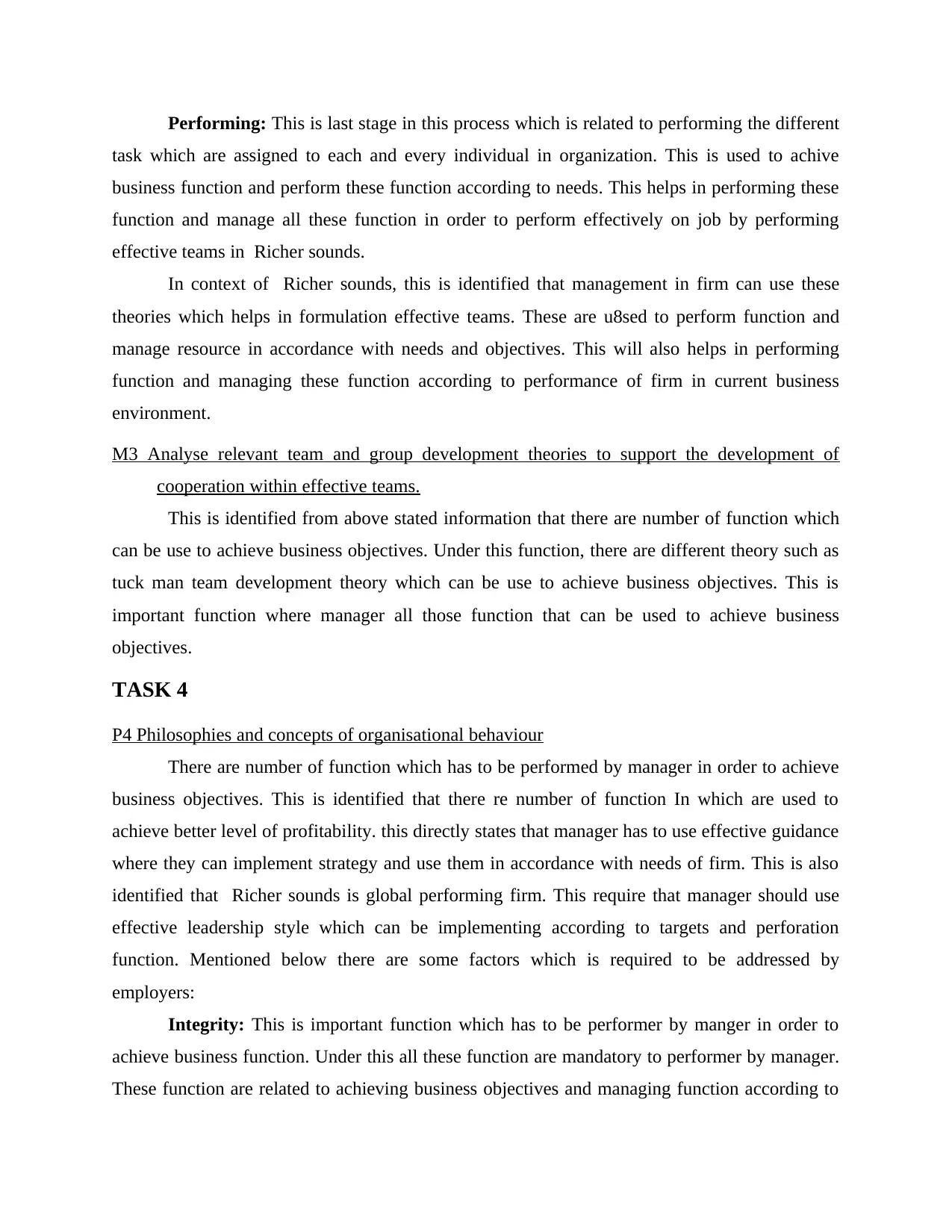
Performing: This is last stage in this process which is related to performing the different
task which are assigned to each and every individual in organization. This is used to achive
business function and perform these function according to needs. This helps in performing these
function and manage all these function in order to perform effectively on job by performing
effective teams in Richer sounds.
In context of Richer sounds, this is identified that management in firm can use these
theories which helps in formulation effective teams. These are u8sed to perform function and
manage resource in accordance with needs and objectives. This will also helps in performing
function and managing these function according to performance of firm in current business
environment.
M3 Analyse relevant team and group development theories to support the development of
cooperation within effective teams.
This is identified from above stated information that there are number of function which
can be use to achieve business objectives. Under this function, there are different theory such as
tuck man team development theory which can be use to achieve business objectives. This is
important function where manager all those function that can be used to achieve business
objectives.
TASK 4
P4 Philosophies and concepts of organisational behaviour
There are number of function which has to be performed by manager in order to achieve
business objectives. This is identified that there re number of function In which are used to
achieve better level of profitability. this directly states that manager has to use effective guidance
where they can implement strategy and use them in accordance with needs of firm. This is also
identified that Richer sounds is global performing firm. This require that manager should use
effective leadership style which can be implementing according to targets and perforation
function. Mentioned below there are some factors which is required to be addressed by
employers:
Integrity: This is important function which has to be performer by manger in order to
achieve business function. Under this all these function are mandatory to performer by manager.
These function are related to achieving business objectives and managing function according to
task which are assigned to each and every individual in organization. This is used to achive
business function and perform these function according to needs. This helps in performing these
function and manage all these function in order to perform effectively on job by performing
effective teams in Richer sounds.
In context of Richer sounds, this is identified that management in firm can use these
theories which helps in formulation effective teams. These are u8sed to perform function and
manage resource in accordance with needs and objectives. This will also helps in performing
function and managing these function according to performance of firm in current business
environment.
M3 Analyse relevant team and group development theories to support the development of
cooperation within effective teams.
This is identified from above stated information that there are number of function which
can be use to achieve business objectives. Under this function, there are different theory such as
tuck man team development theory which can be use to achieve business objectives. This is
important function where manager all those function that can be used to achieve business
objectives.
TASK 4
P4 Philosophies and concepts of organisational behaviour
There are number of function which has to be performed by manager in order to achieve
business objectives. This is identified that there re number of function In which are used to
achieve better level of profitability. this directly states that manager has to use effective guidance
where they can implement strategy and use them in accordance with needs of firm. This is also
identified that Richer sounds is global performing firm. This require that manager should use
effective leadership style which can be implementing according to targets and perforation
function. Mentioned below there are some factors which is required to be addressed by
employers:
Integrity: This is important function which has to be performer by manger in order to
achieve business function. Under this all these function are mandatory to performer by manager.
These function are related to achieving business objectives and managing function according to
Secure Best Marks with AI Grader
Need help grading? Try our AI Grader for instant feedback on your assignments.
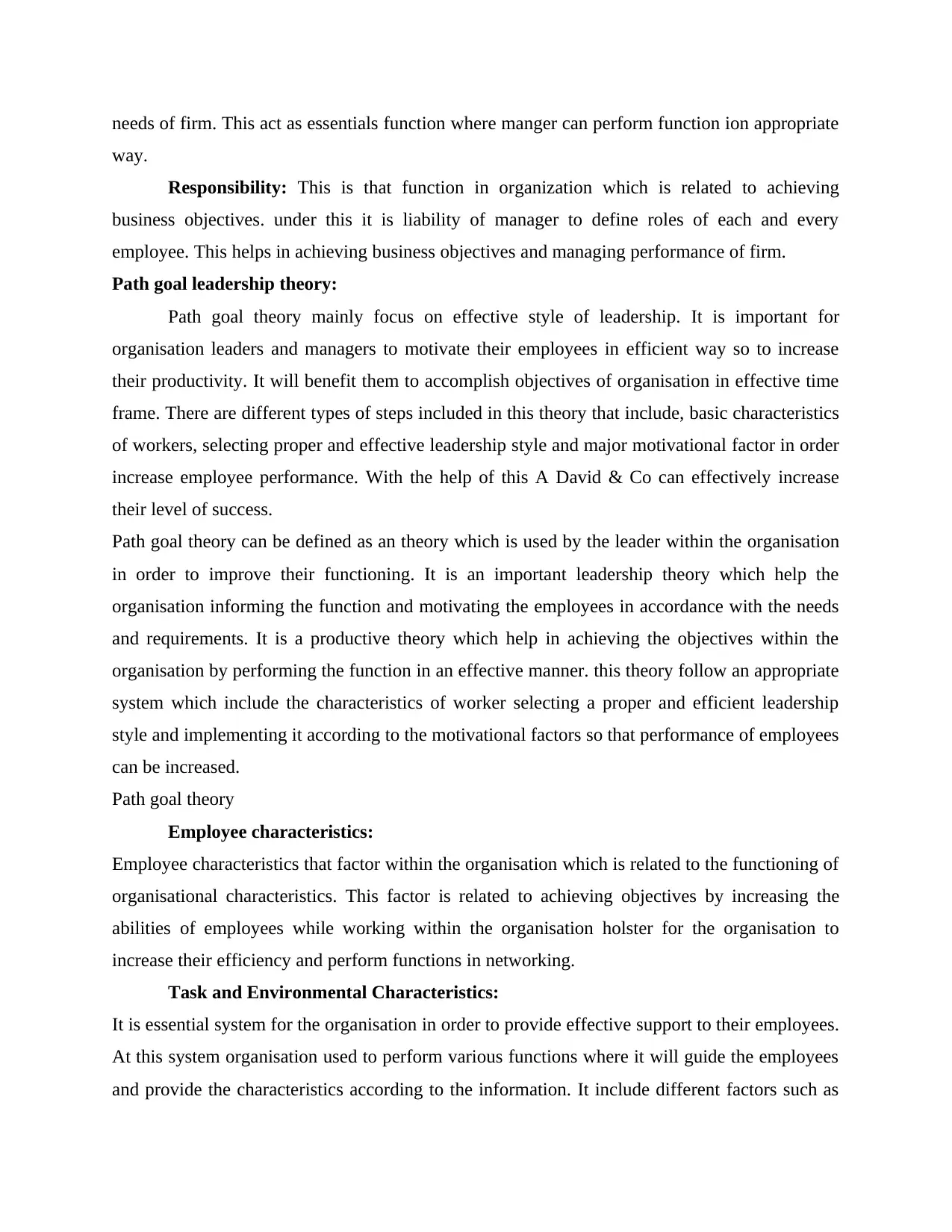
needs of firm. This act as essentials function where manger can perform function ion appropriate
way.
Responsibility: This is that function in organization which is related to achieving
business objectives. under this it is liability of manager to define roles of each and every
employee. This helps in achieving business objectives and managing performance of firm.
Path goal leadership theory:
Path goal theory mainly focus on effective style of leadership. It is important for
organisation leaders and managers to motivate their employees in efficient way so to increase
their productivity. It will benefit them to accomplish objectives of organisation in effective time
frame. There are different types of steps included in this theory that include, basic characteristics
of workers, selecting proper and effective leadership style and major motivational factor in order
increase employee performance. With the help of this A David & Co can effectively increase
their level of success.
Path goal theory can be defined as an theory which is used by the leader within the organisation
in order to improve their functioning. It is an important leadership theory which help the
organisation informing the function and motivating the employees in accordance with the needs
and requirements. It is a productive theory which help in achieving the objectives within the
organisation by performing the function in an effective manner. this theory follow an appropriate
system which include the characteristics of worker selecting a proper and efficient leadership
style and implementing it according to the motivational factors so that performance of employees
can be increased.
Path goal theory
Employee characteristics:
Employee characteristics that factor within the organisation which is related to the functioning of
organisational characteristics. This factor is related to achieving objectives by increasing the
abilities of employees while working within the organisation holster for the organisation to
increase their efficiency and perform functions in networking.
Task and Environmental Characteristics:
It is essential system for the organisation in order to provide effective support to their employees.
At this system organisation used to perform various functions where it will guide the employees
and provide the characteristics according to the information. It include different factors such as
way.
Responsibility: This is that function in organization which is related to achieving
business objectives. under this it is liability of manager to define roles of each and every
employee. This helps in achieving business objectives and managing performance of firm.
Path goal leadership theory:
Path goal theory mainly focus on effective style of leadership. It is important for
organisation leaders and managers to motivate their employees in efficient way so to increase
their productivity. It will benefit them to accomplish objectives of organisation in effective time
frame. There are different types of steps included in this theory that include, basic characteristics
of workers, selecting proper and effective leadership style and major motivational factor in order
increase employee performance. With the help of this A David & Co can effectively increase
their level of success.
Path goal theory can be defined as an theory which is used by the leader within the organisation
in order to improve their functioning. It is an important leadership theory which help the
organisation informing the function and motivating the employees in accordance with the needs
and requirements. It is a productive theory which help in achieving the objectives within the
organisation by performing the function in an effective manner. this theory follow an appropriate
system which include the characteristics of worker selecting a proper and efficient leadership
style and implementing it according to the motivational factors so that performance of employees
can be increased.
Path goal theory
Employee characteristics:
Employee characteristics that factor within the organisation which is related to the functioning of
organisational characteristics. This factor is related to achieving objectives by increasing the
abilities of employees while working within the organisation holster for the organisation to
increase their efficiency and perform functions in networking.
Task and Environmental Characteristics:
It is essential system for the organisation in order to provide effective support to their employees.
At this system organisation used to perform various functions where it will guide the employees
and provide the characteristics according to the information. It include different factors such as
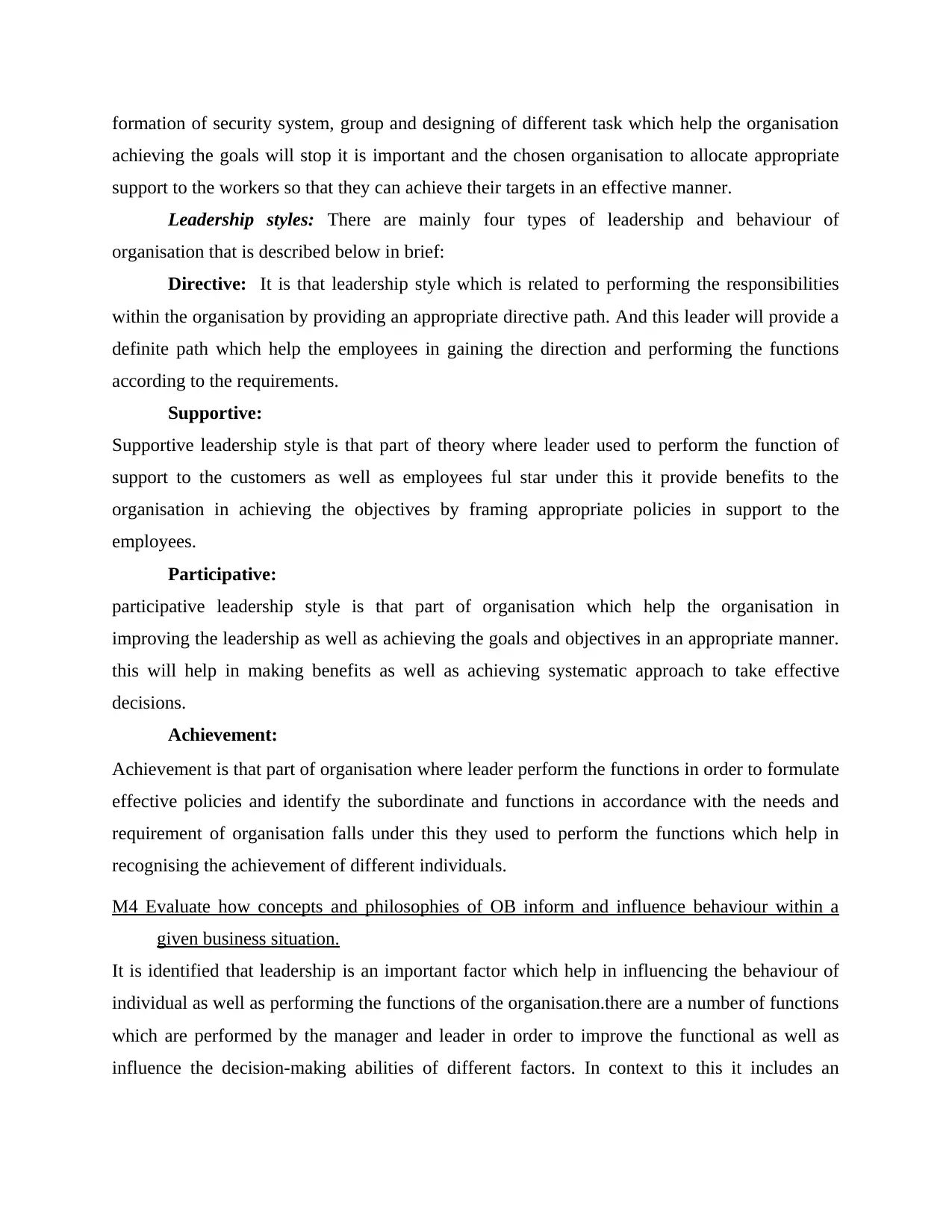
formation of security system, group and designing of different task which help the organisation
achieving the goals will stop it is important and the chosen organisation to allocate appropriate
support to the workers so that they can achieve their targets in an effective manner.
Leadership styles: There are mainly four types of leadership and behaviour of
organisation that is described below in brief:
Directive: It is that leadership style which is related to performing the responsibilities
within the organisation by providing an appropriate directive path. And this leader will provide a
definite path which help the employees in gaining the direction and performing the functions
according to the requirements.
Supportive:
Supportive leadership style is that part of theory where leader used to perform the function of
support to the customers as well as employees ful star under this it provide benefits to the
organisation in achieving the objectives by framing appropriate policies in support to the
employees.
Participative:
participative leadership style is that part of organisation which help the organisation in
improving the leadership as well as achieving the goals and objectives in an appropriate manner.
this will help in making benefits as well as achieving systematic approach to take effective
decisions.
Achievement:
Achievement is that part of organisation where leader perform the functions in order to formulate
effective policies and identify the subordinate and functions in accordance with the needs and
requirement of organisation falls under this they used to perform the functions which help in
recognising the achievement of different individuals.
M4 Evaluate how concepts and philosophies of OB inform and influence behaviour within a
given business situation.
It is identified that leadership is an important factor which help in influencing the behaviour of
individual as well as performing the functions of the organisation.there are a number of functions
which are performed by the manager and leader in order to improve the functional as well as
influence the decision-making abilities of different factors. In context to this it includes an
achieving the goals will stop it is important and the chosen organisation to allocate appropriate
support to the workers so that they can achieve their targets in an effective manner.
Leadership styles: There are mainly four types of leadership and behaviour of
organisation that is described below in brief:
Directive: It is that leadership style which is related to performing the responsibilities
within the organisation by providing an appropriate directive path. And this leader will provide a
definite path which help the employees in gaining the direction and performing the functions
according to the requirements.
Supportive:
Supportive leadership style is that part of theory where leader used to perform the function of
support to the customers as well as employees ful star under this it provide benefits to the
organisation in achieving the objectives by framing appropriate policies in support to the
employees.
Participative:
participative leadership style is that part of organisation which help the organisation in
improving the leadership as well as achieving the goals and objectives in an appropriate manner.
this will help in making benefits as well as achieving systematic approach to take effective
decisions.
Achievement:
Achievement is that part of organisation where leader perform the functions in order to formulate
effective policies and identify the subordinate and functions in accordance with the needs and
requirement of organisation falls under this they used to perform the functions which help in
recognising the achievement of different individuals.
M4 Evaluate how concepts and philosophies of OB inform and influence behaviour within a
given business situation.
It is identified that leadership is an important factor which help in influencing the behaviour of
individual as well as performing the functions of the organisation.there are a number of functions
which are performed by the manager and leader in order to improve the functional as well as
influence the decision-making abilities of different factors. In context to this it includes an
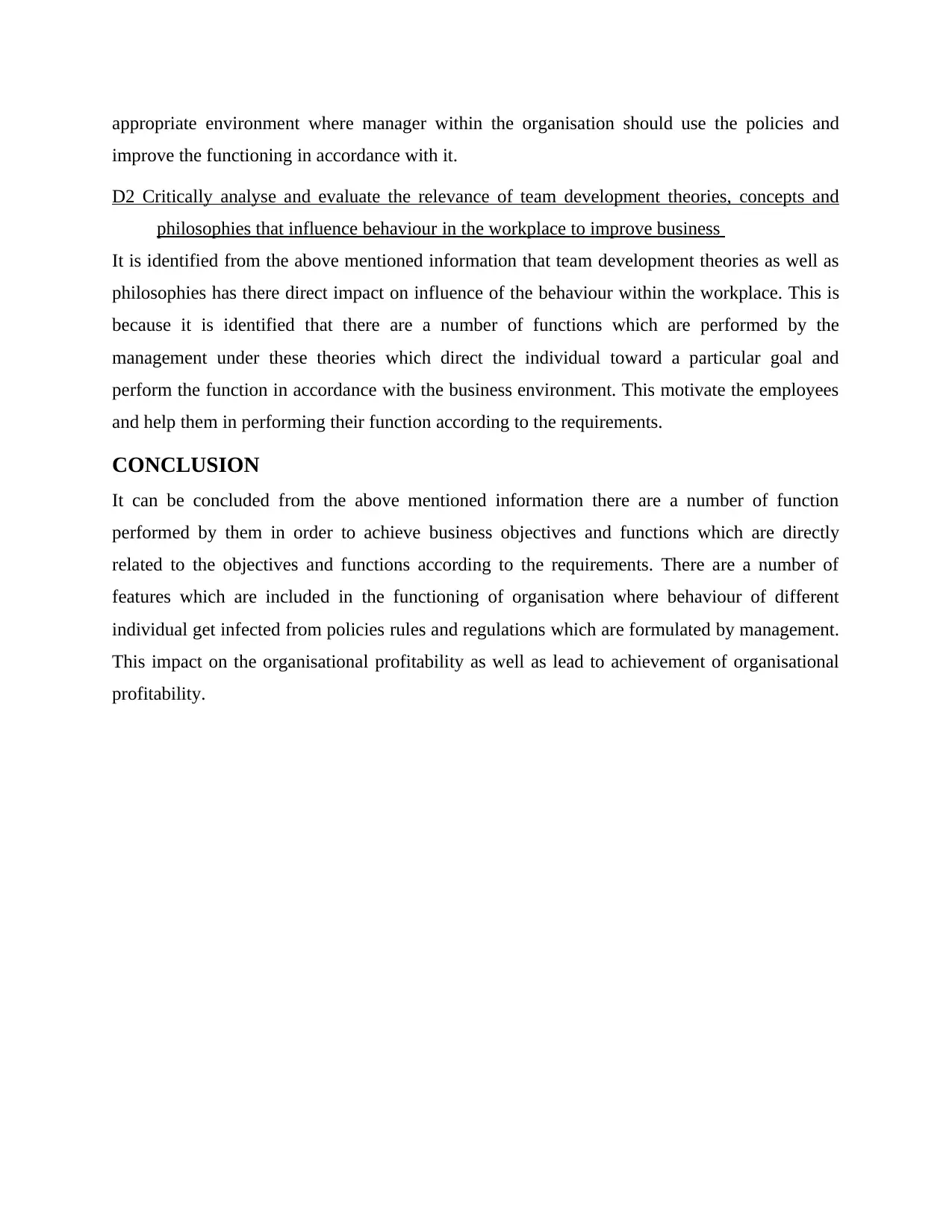
appropriate environment where manager within the organisation should use the policies and
improve the functioning in accordance with it.
D2 Critically analyse and evaluate the relevance of team development theories, concepts and
philosophies that influence behaviour in the workplace to improve business
It is identified from the above mentioned information that team development theories as well as
philosophies has there direct impact on influence of the behaviour within the workplace. This is
because it is identified that there are a number of functions which are performed by the
management under these theories which direct the individual toward a particular goal and
perform the function in accordance with the business environment. This motivate the employees
and help them in performing their function according to the requirements.
CONCLUSION
It can be concluded from the above mentioned information there are a number of function
performed by them in order to achieve business objectives and functions which are directly
related to the objectives and functions according to the requirements. There are a number of
features which are included in the functioning of organisation where behaviour of different
individual get infected from policies rules and regulations which are formulated by management.
This impact on the organisational profitability as well as lead to achievement of organisational
profitability.
improve the functioning in accordance with it.
D2 Critically analyse and evaluate the relevance of team development theories, concepts and
philosophies that influence behaviour in the workplace to improve business
It is identified from the above mentioned information that team development theories as well as
philosophies has there direct impact on influence of the behaviour within the workplace. This is
because it is identified that there are a number of functions which are performed by the
management under these theories which direct the individual toward a particular goal and
perform the function in accordance with the business environment. This motivate the employees
and help them in performing their function according to the requirements.
CONCLUSION
It can be concluded from the above mentioned information there are a number of function
performed by them in order to achieve business objectives and functions which are directly
related to the objectives and functions according to the requirements. There are a number of
features which are included in the functioning of organisation where behaviour of different
individual get infected from policies rules and regulations which are formulated by management.
This impact on the organisational profitability as well as lead to achievement of organisational
profitability.
Paraphrase This Document
Need a fresh take? Get an instant paraphrase of this document with our AI Paraphraser
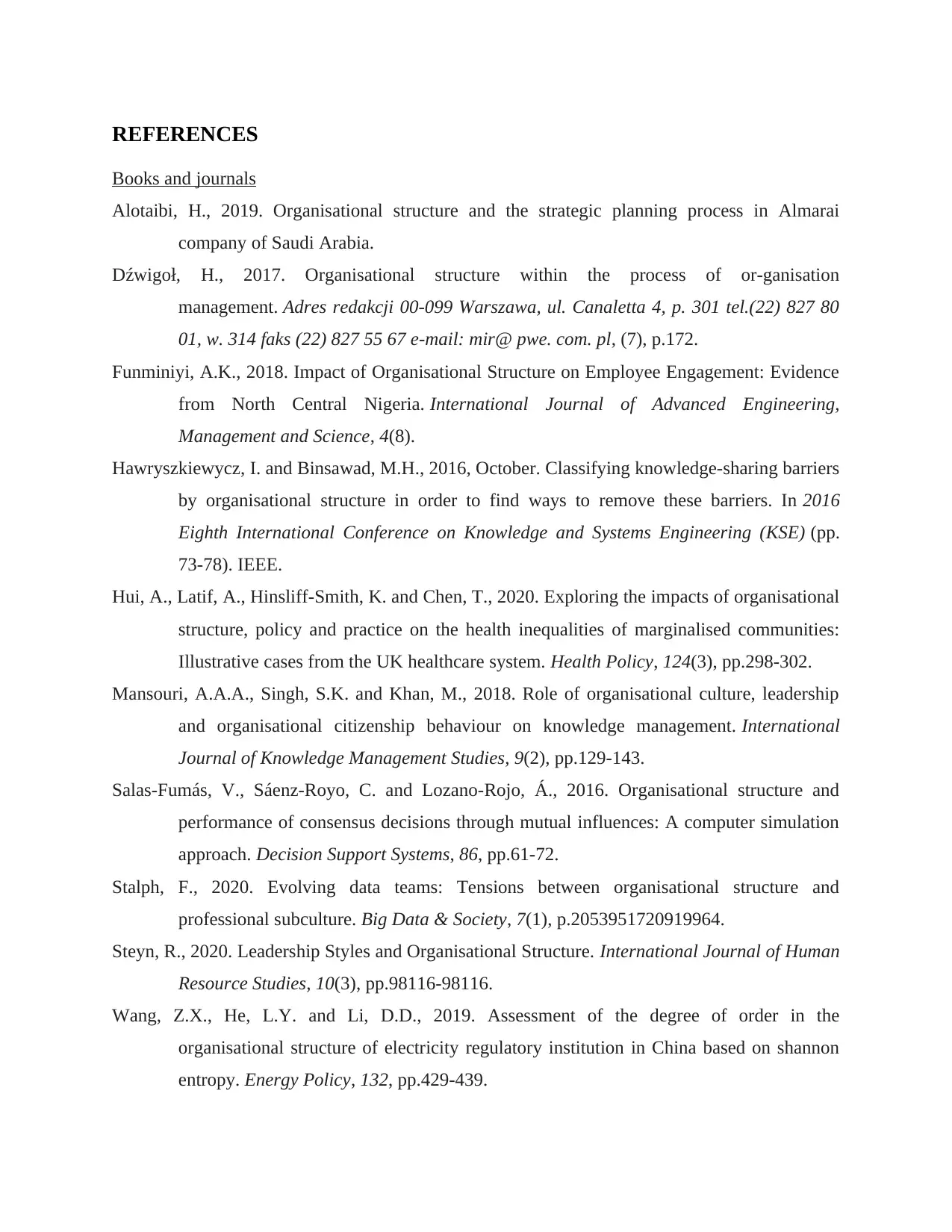
REFERENCES
Books and journals
Alotaibi, H., 2019. Organisational structure and the strategic planning process in Almarai
company of Saudi Arabia.
Dźwigoł, H., 2017. Organisational structure within the process of or-ganisation
management. Adres redakcji 00-099 Warszawa, ul. Canaletta 4, p. 301 tel.(22) 827 80
01, w. 314 faks (22) 827 55 67 e-mail: mir@ pwe. com. pl, (7), p.172.
Funminiyi, A.K., 2018. Impact of Organisational Structure on Employee Engagement: Evidence
from North Central Nigeria. International Journal of Advanced Engineering,
Management and Science, 4(8).
Hawryszkiewycz, I. and Binsawad, M.H., 2016, October. Classifying knowledge-sharing barriers
by organisational structure in order to find ways to remove these barriers. In 2016
Eighth International Conference on Knowledge and Systems Engineering (KSE) (pp.
73-78). IEEE.
Hui, A., Latif, A., Hinsliff-Smith, K. and Chen, T., 2020. Exploring the impacts of organisational
structure, policy and practice on the health inequalities of marginalised communities:
Illustrative cases from the UK healthcare system. Health Policy, 124(3), pp.298-302.
Mansouri, A.A.A., Singh, S.K. and Khan, M., 2018. Role of organisational culture, leadership
and organisational citizenship behaviour on knowledge management. International
Journal of Knowledge Management Studies, 9(2), pp.129-143.
Salas-Fumás, V., Sáenz-Royo, C. and Lozano-Rojo, Á., 2016. Organisational structure and
performance of consensus decisions through mutual influences: A computer simulation
approach. Decision Support Systems, 86, pp.61-72.
Stalph, F., 2020. Evolving data teams: Tensions between organisational structure and
professional subculture. Big Data & Society, 7(1), p.2053951720919964.
Steyn, R., 2020. Leadership Styles and Organisational Structure. International Journal of Human
Resource Studies, 10(3), pp.98116-98116.
Wang, Z.X., He, L.Y. and Li, D.D., 2019. Assessment of the degree of order in the
organisational structure of electricity regulatory institution in China based on shannon
entropy. Energy Policy, 132, pp.429-439.
Books and journals
Alotaibi, H., 2019. Organisational structure and the strategic planning process in Almarai
company of Saudi Arabia.
Dźwigoł, H., 2017. Organisational structure within the process of or-ganisation
management. Adres redakcji 00-099 Warszawa, ul. Canaletta 4, p. 301 tel.(22) 827 80
01, w. 314 faks (22) 827 55 67 e-mail: mir@ pwe. com. pl, (7), p.172.
Funminiyi, A.K., 2018. Impact of Organisational Structure on Employee Engagement: Evidence
from North Central Nigeria. International Journal of Advanced Engineering,
Management and Science, 4(8).
Hawryszkiewycz, I. and Binsawad, M.H., 2016, October. Classifying knowledge-sharing barriers
by organisational structure in order to find ways to remove these barriers. In 2016
Eighth International Conference on Knowledge and Systems Engineering (KSE) (pp.
73-78). IEEE.
Hui, A., Latif, A., Hinsliff-Smith, K. and Chen, T., 2020. Exploring the impacts of organisational
structure, policy and practice on the health inequalities of marginalised communities:
Illustrative cases from the UK healthcare system. Health Policy, 124(3), pp.298-302.
Mansouri, A.A.A., Singh, S.K. and Khan, M., 2018. Role of organisational culture, leadership
and organisational citizenship behaviour on knowledge management. International
Journal of Knowledge Management Studies, 9(2), pp.129-143.
Salas-Fumás, V., Sáenz-Royo, C. and Lozano-Rojo, Á., 2016. Organisational structure and
performance of consensus decisions through mutual influences: A computer simulation
approach. Decision Support Systems, 86, pp.61-72.
Stalph, F., 2020. Evolving data teams: Tensions between organisational structure and
professional subculture. Big Data & Society, 7(1), p.2053951720919964.
Steyn, R., 2020. Leadership Styles and Organisational Structure. International Journal of Human
Resource Studies, 10(3), pp.98116-98116.
Wang, Z.X., He, L.Y. and Li, D.D., 2019. Assessment of the degree of order in the
organisational structure of electricity regulatory institution in China based on shannon
entropy. Energy Policy, 132, pp.429-439.
1 out of 14
Related Documents
Your All-in-One AI-Powered Toolkit for Academic Success.
+13062052269
info@desklib.com
Available 24*7 on WhatsApp / Email
![[object Object]](/_next/static/media/star-bottom.7253800d.svg)
Unlock your academic potential
© 2024 | Zucol Services PVT LTD | All rights reserved.




